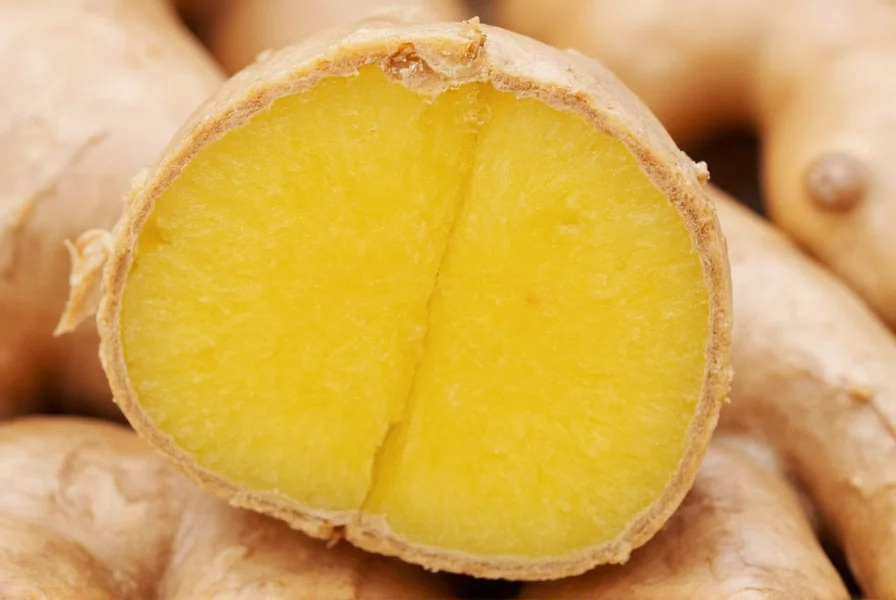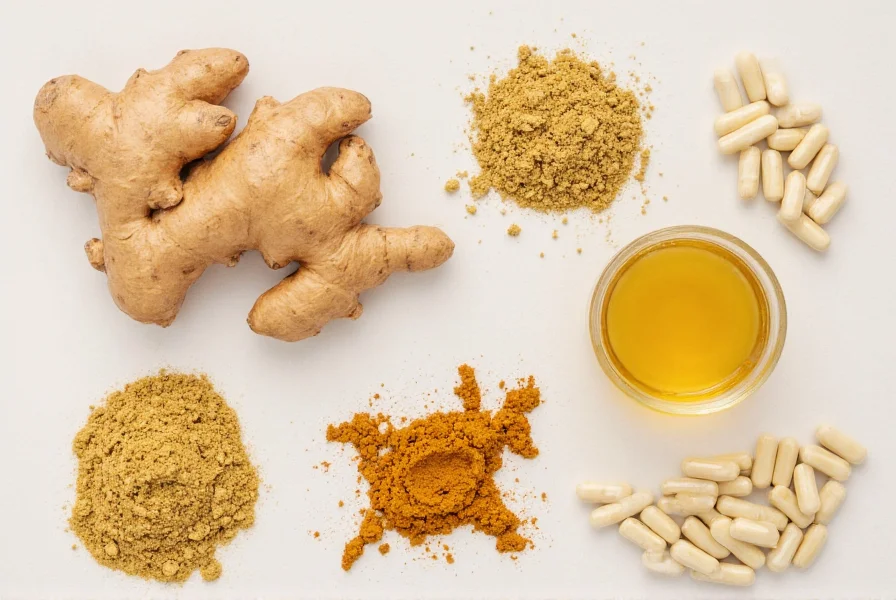When exploring ginger nutrition, it's essential to understand both the basic nutritional profile and the bioactive compounds that make this root unique. Ginger (Zingiber officinale) has been used for centuries in traditional medicine systems across Asia, and modern science continues to validate many of its health properties. This comprehensive guide examines ginger's nutritional composition, evidence-based health benefits, and practical consumption recommendations based on current scientific understanding.
Nutritional Composition of Ginger
Ginger's nutritional value extends beyond basic macronutrients. While it's low in calories, it packs a powerful array of micronutrients and bioactive compounds. The nutritional profile varies slightly depending on whether ginger is consumed fresh, dried, or as an extract.
| Nutrient | Per 1 Tbsp Raw Ginger (6g) | Per 1 Tbsp Ground Ginger (2g) |
|---|---|---|
| Calories | 5 | 6 |
| Total Fat | 0.1g | 0.1g |
| Carbohydrates | 1.3g | 1.4g |
| Dietary Fiber | 0.1g | 0.2g |
| Sugar | 0.1g | 0g |
| Protein | 0.1g | 0.1g |
| Vitamin B6 | 2% of DV | 1% of DV |
| Magnesium | 1% of DV | 2% of DV |
| Potassium | 1% of DV | 2% of DV |
Key Bioactive Compounds in Ginger
The true nutritional significance of ginger lies in its bioactive compounds rather than its basic macronutrient profile. These compounds are responsible for ginger's distinctive flavor and many of its studied health effects:
- Gingerols - The primary pungent compounds in fresh ginger, particularly 6-gingerol, which has been extensively studied for its anti-inflammatory and antioxidant properties
- Shogaols - Formed when ginger is dried or heated, these compounds may have even stronger biological activity than gingerols
- Zingerone - Another compound that contributes to ginger's flavor profile and potential health benefits
- Paradols - Metabolites of shogaols with potential antioxidant effects
These compounds work synergistically to provide ginger's characteristic effects. Research published in the International Journal of Preventive Medicine indicates that ginger contains over 400 different compounds, many of which contribute to its therapeutic potential.

Evidence-Based Health Benefits of Ginger
Understanding ginger nutritional benefits requires examining the scientific evidence behind its health claims. While traditional medicine has long praised ginger, modern research helps distinguish evidence-based benefits from anecdotal claims.
Digestive Health Support
One of the most well-documented ginger nutrition benefits is its positive effect on digestive health. Multiple studies, including research published in Nutrition Journal, have shown that ginger can accelerate gastric emptying, which may help reduce symptoms of indigestion. The European Medicines Agency recognizes ginger as a traditional herbal remedy for mild digestive issues.
Nausea and Vomiting Relief
Ginger's effectiveness against nausea is one of its most scientifically supported benefits. A comprehensive review in Obstetrics & Gynecology found that ginger significantly reduces pregnancy-related nausea. Similarly, research in Supportive Care in Cancer indicates ginger may help reduce chemotherapy-induced nausea when used alongside conventional treatments.
Inflammation Reduction
The anti-inflammatory properties of ginger nutrition components, particularly gingerols, have been extensively studied. Research in Arthritis demonstrated that ginger extract reduced pain and stiffness in osteoarthritis patients. These effects appear to work through multiple pathways, including inhibition of inflammatory cytokines.
Blood Sugar Regulation
Emerging research suggests ginger nutrition may support healthy blood sugar levels. A 2015 study in Complementary Therapies in Medicine found that ginger supplementation significantly reduced fasting blood sugar and improved HbA1c levels in type 2 diabetes patients. However, more research is needed to determine optimal dosing and long-term effects.
Practical Consumption Guidelines
Understanding how to incorporate ginger into your diet requires knowledge of effective dosages and preparation methods. The appropriate amount varies based on your specific health goals:
- General wellness: 1-1.5 grams of fresh ginger daily (about 1-2 thumb-sized slices)
- Nausea relief: 1-2 grams of fresh ginger or 250-500mg of standardized extract
- Inflammation support: 2 grams of fresh ginger or 75-200mg of gingerol extract
Various forms of ginger offer different concentrations of active compounds:
- Fresh ginger: Highest in gingerols, ideal for culinary use
- Dried ginger powder: Higher in shogaols due to the drying process
- Ginger tea: Provides moderate concentrations of active compounds
- Standardized extracts: Offer consistent dosing of specific compounds

Safety Considerations and Potential Interactions
While ginger nutrition is generally safe for most people, certain considerations are important:
- Blood thinning: Ginger may enhance the effects of blood-thinning medications like warfarin
- Blood pressure: May interact with blood pressure medications due to potential hypotensive effects
- Gallstones: May increase bile production, potentially problematic for those with gallstones
- Pregnancy: Generally considered safe in food amounts, but high doses should be discussed with a healthcare provider
The recommended upper limit for daily ginger consumption is generally considered to be 4 grams. Most people tolerate ginger well, but some may experience mild heartburn or stomach upset, particularly when consuming larger amounts.
Maximizing Ginger's Nutritional Benefits
To get the most from ginger nutrition in your diet, consider these evidence-based strategies:
- Pair with black pepper: Piperine in black pepper may enhance the absorption of ginger's active compounds
- Use fresh when possible: Fresh ginger contains higher levels of gingerols compared to dried forms
- Don't peel excessively: Many beneficial compounds are concentrated just beneath the skin
- Combine with healthy fats: The bioactive compounds in ginger are fat-soluble, so consuming with healthy fats may improve absorption
For culinary applications, adding ginger early in the cooking process preserves more of its volatile compounds, while adding it later maintains more of its pungent flavor. When making ginger tea, letting it steep for 10-15 minutes extracts more of the beneficial compounds.
Conclusion
Ginger nutrition offers a compelling combination of basic nutrients and powerful bioactive compounds that contribute to its wide-ranging health benefits. While not a miracle cure, the scientific evidence supporting ginger's role in digestive health, nausea reduction, and inflammation management is substantial. When incorporated as part of a balanced diet, ginger provides both culinary versatility and potential health advantages. As with any dietary component, moderation and consideration of individual health circumstances remain important for maximizing benefits while minimizing potential risks.
Frequently Asked Questions About Ginger Nutrition
What is the most nutritious form of ginger to consume?
Fresh ginger generally contains the highest concentration of gingerols, the primary bioactive compounds. However, dried ginger contains higher levels of shogaols, which form during the drying process and may have even stronger biological activity. For maximum nutritional benefit, incorporating both fresh and dried forms into your diet provides a broader spectrum of beneficial compounds.
How much ginger should I consume daily for health benefits?
For general wellness, 1-1.5 grams of fresh ginger daily (approximately one thumb-sized slice) is sufficient. For specific therapeutic purposes like nausea relief, research suggests 1-2 grams of fresh ginger or 250-500mg of standardized extract. The maximum recommended daily intake is 4 grams to avoid potential side effects.
Does cooking ginger reduce its nutritional value?
Cooking ginger transforms rather than destroys its beneficial compounds. Heat converts gingerols to shogaols, which may have even stronger anti-inflammatory properties. While some volatile compounds may be lost during prolonged cooking, the overall nutritional profile remains beneficial. For maximum compound diversity, use ginger both raw (in smoothies or juices) and cooked (in stir-fries or teas).
Can ginger help with weight loss as part of nutrition plans?
Some research suggests ginger may support weight management through several mechanisms, including potential effects on metabolism, fat burning, and appetite regulation. A study in the journal Metabolism found that ginger consumption increased thermogenesis and reduced feelings of hunger. However, ginger should be viewed as a complementary component of a comprehensive weight management strategy rather than a standalone solution.
How does ginger nutrition compare to turmeric?
Both ginger and turmeric belong to the same plant family (Zingiberaceae) and share some similar properties, particularly anti-inflammatory effects. Ginger primarily contains gingerols while turmeric's key compound is curcumin. Ginger tends to be more effective for digestive issues and nausea, while turmeric shows stronger evidence for joint health. Combining both in your diet provides complementary benefits, and black pepper enhances the absorption of both.











 浙公网安备
33010002000092号
浙公网安备
33010002000092号 浙B2-20120091-4
浙B2-20120091-4